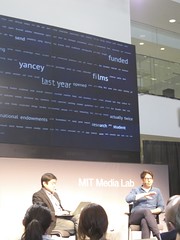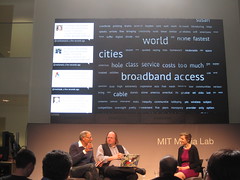Last week at a White House event, President Obama announced his Brain Research through Advancing Innovative Neurotechnologies (BRAIN) Initiative. Calling it "the next great American project," Obama allocated $100 million per year, starting in fiscal year 2014, for developing new tools to map the activity of the networks of the brain. In December of 2012 I contributed to a technology roadmap workshop for the initiative, and last week I was invited to participate in the official White House launch, along with other neuroscientists, engineers, and government officials.
The potential impact is huge. Understanding how sensations, decisions, emotions, and actions are generated by brain circuits has tremendous implications for understanding the human condition. Revealing the activity patterns associated with brain disorders, and their treatment, could help the one billion people worldwide who are afflicted with poorly treatable conditions ranging from epilepsy to Alzheimer’s. The technologies we develop in the Synthetic Neurobiology group at MIT, often in interdisciplinary collaborations, will provide key technology building blocks for this effort. These tools include optogenetic tools for controlling brain circuits with light, microfabricated 3D brain-spanning neural interfaces, and robots that automatically analyze single cells in the living brain.
Our group is a joint enterprise across multiple MIT institutes, such as the Media Lab and the McGovern Institute, and many departments such as Biological Engineering and Brain and Cognitive Sciences. We also work closely with other institutes like the Allen Institute for Brain Science. It’s instructive to take a look at one of these environments, the MIT Media Lab, and how it has helped the relatively new field of neurotechnology thrive, perhaps in unexpected ways. The Media Lab provides an antidisciplinary environment where fields that don’t fit within existing disciplines can be incubated and nurtured by people who believe in them. Giving a field some protected time to develop and ultimately prove itself, and to derive its methodologies of thinking, doing, and evaluating, is important for enabling it to mature to the point of having impact on the world.
One important methodology in neurotechnology is to engage in co-equal collaborations. For example, the brain-spanning interfaces were developed in collaboration with the Fonstad lab at MIT, and the single-neuron analysis robot was developed in collaboration with the Forest lab at Georgia Tech. To help people create impactful neurotechnology inventions, we have developed courses ranging from those that teach basic principles, to those that mentor people in the process of launching neurotechnology startup companies. It wasn’t all fun and games—for example, we had to renovate old film studios and holography rooms into functioning bioengineering labs, which took years. But it has been said that entrepreneurship is the pursuit of opportunity independent of the resources that you currently control. What you need is the right environment, and the potential to access resources and grow. The Media Lab lets us practice intellectual entrepreneurship, and over the last seven years, we have been able to accomplish this kind of growth, both within our group and in the field globally.
No field stays antidisciplinary forever. Technologies developed by our group are used all over the world. Our alumni and collaborators have been building new research groups, and startup companies, that are pushing the field of neurotechnology forward, both academically and from an industry-building standpoint. Certainly the White House announcement means that neurotechnology is in some ways going mainstream. The field is poised to grow and accelerate in ways not imaginable seven years ago. We are looking forward to helping build new technologies and new collaborative networks to make new technologies. And, always in the background is the question—prompted each time I walk down the hallways of the Media Lab complex—is it time to start incubating something new?
Ed Boyden is Benesse Career Development Professor and Associate Professor of Media Arts and Sciences at the MIT Media Lab. He is the head of the Synthetic Neurobiology group, and has joint appointments with MIT's Departments of Biological Engineering and Brain and Cognitive Sciences. He is an investigator at the MIT McGovern Institute.


